
views
Using a Lead Acid Battery Charger

Charge your battery in a well-ventilated location. Select a location like a garage or large shed. Open a door or window if you can. Good ventilation is important because, during the charging process, a mixture of gases builds up in your battery, and if the battery is overcharged or shorts out, these gases may vent out of the battery. If the battery is somewhere with poor ventilation, this may lead to an explosion. The ventilation in most enclosures should be sufficient to minimize this risk. The ventilation in a small, enclosed shed, crawlspace, or other small room, however, may not be enough.
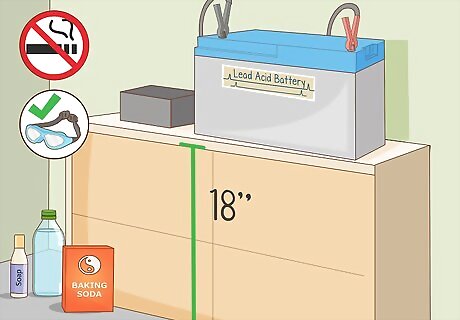
Take proper precautions whenever handling a lead acid battery. Wear protective eye glasses and gloves to protect yourself from any acid that may leak from the battery. Keep flammable materials and items that may produce a spark (like electronics) away from the battery. And keep the battery at least 18 inches (46 cm) above the floor. Never smoke anywhere near a lead acid battery. Do not try to charge a battery that is frozen, damaged, or leaking. If battery acid splashes into your eyes or skin, flush the affected area with lukewarm running water for at least 30 continuous minutes and seek immediate medical attention. Keep baking soda nearby. If battery acid splashes on any surface, cover the spill area with baking soda to neutralize the acid. Rinse off your gloves thoroughly after handling a lead acid battery, and then, use soap and water to wash yourself.
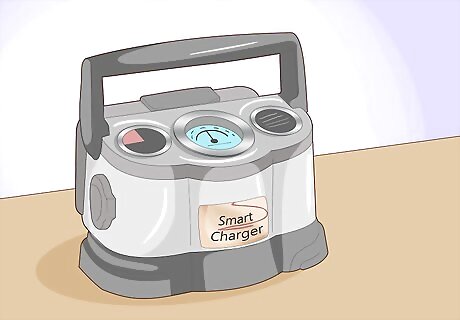
Use a smart lead acid battery charger to charge your battery. Lead acid batteries need to be charged in various stages and voltages. This can be difficult to do, so the best way to charge your battery is to use a smart charger that automates the multi-stage process. These smart chargers have microprocessors that monitor the battery and adjust the current and voltage as required for an optimal charge. Using a multi-stage smart charger will reduce the risk of overcharging or undercharging your battery. You can purchase a lead acid battery charger at most large home improvement stores. Buy a charger with a desulfation mode to maintain the performance of your battery. This mode will breakdown the lead sulfate crystals in your battery. Follow the directions in the owner’s manual that came with your specific battery to use this mode.
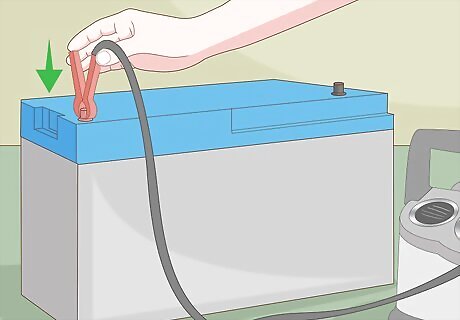
Connect the charger’s red positive (+) cable clamp to the positive (+) post. When handling the cable clamp, be sure to touch only the colored plastic section and not the metal. Squeeze the clamp and position the teeth of the clamp securely on the post on the battery. Keep the battery charger disconnected from the power source for this step. Position the charger as far away from the battery as the cables will allow, just in case the charger malfunctions and sparks. Place the charger to the side of the battery at the same height level, not above or below it.
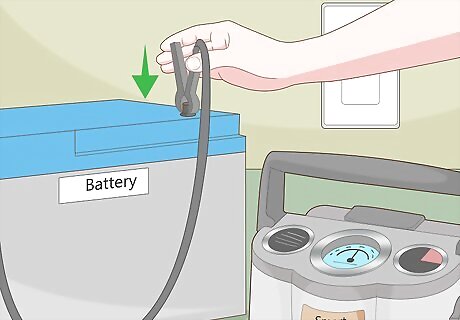
Secure the black negative (-) cable clamp to the negative (-) post. Follow the same process you used when connecting the red clamp to the positive post. As you’re securing the cable clamps to the corresponding posts on the battery, avoid letting the cable clamps touch one another. If you’ll be charging your battery while it is still in your vehicle, connect the negative cable clamp to the vehicle’s chassis. Keep the battery charger disconnected from the power source for this step, as well.
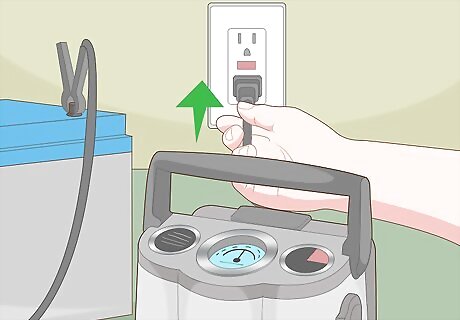
Plug the charger into a grounded GFCI protected outlet. Look for an outlet with a red “Reset” button in the middle. This type of outlet will help protect you from electrical shock when using your battery charger. A ground-fault circuit interrupter (GFCI) outlet controls the amount of power that goes to a device that is plugged in, and will cut power if it detects a power imbalance that may cause an electrical shock. Do not plug the charger into a plug adapter of any sort. Plug it directly into the outlet.
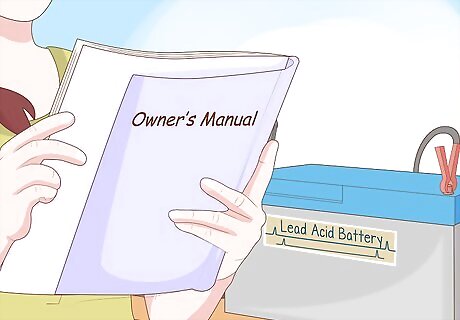
Look up the type of your battery to know what charge setting to select. Look at the owner’s manual that came with your battery to find the specific type of your battery. If you don’t have an owner’s manual, look for the manufacturer’s name and part number on the battery, then look it up online or call the manufacturer. The manufacturer’s name and part number are usually printed on the battery’s front. You’ll want to pay special attention to whether your battery is a flooded lead acid, an AGM (Absorbed Glass Matt), or a gel battery.
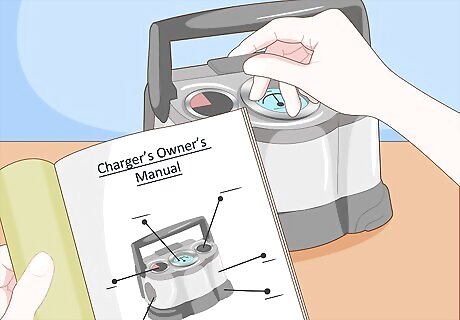
Find the setting on your charger that matches the type of your battery. All smart chargers have different displays and settings. To find the proper programmed setting for your battery, look for a table or guide in your charger’s owner’s manual that explains which settings should be used for what types of batteries. Some advanced chargers will have a quick set option with a handful of general battery types from which to choose. Others will have a screen where you can punch in the specific voltage and current specifications provided by the manufacturer of your battery.
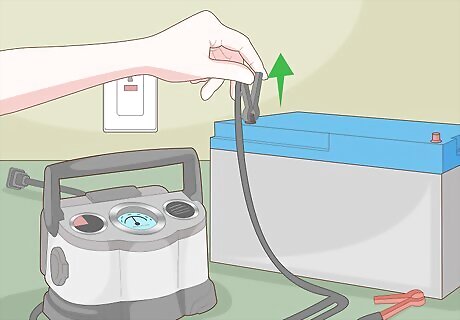
Turn off and unplug your charger before disconnecting the clamps. Once your battery has finished charging (a process that may take several hours), turn off your device. Then, remove the charger cord from the electric outlet. Unplug the negative (-) cable clamp first and then the positive (+) clamp. The display on your charger will let you know when the battery is done charging. Pull on the plug instead of the cord when removing the power cord from the outlet. Stand as far away from the battery as you can when disconnecting the cable clamps.
Optimizing Your Battery’s Energy
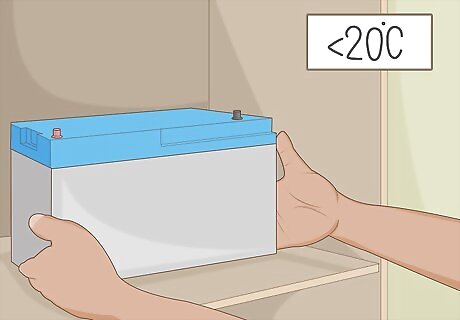
Store lead acid batteries at 20 °C (68 °F) or lower, if possible. Lead acid batteries lose capacity when stored. The rate of this loss in capacity, or self-discharge, varies with temperature, increasing at higher temperatures. Storing your battery at temperatures colder than 20 °C (68 °F) will result in even less loss of capacity.
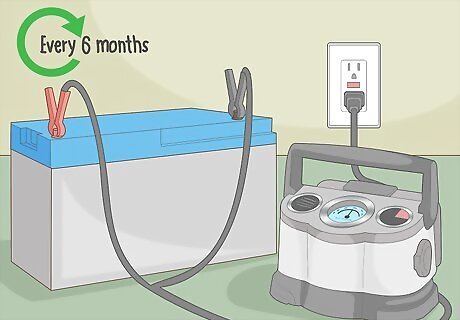
Charge your battery at least every 6 months when it’s in storage. When stored at 20 °C (68 °F), your lead acid battery will lose about 3 percent of its capacity per month. If you store your battery for a long period without charging it, especially at temperatures higher than 20 °C (68 °F), it may experience a permanent loss of capacity. Read the owner’s manual that came with your specific battery, as storage recommendations for different lead acid batteries may vary.
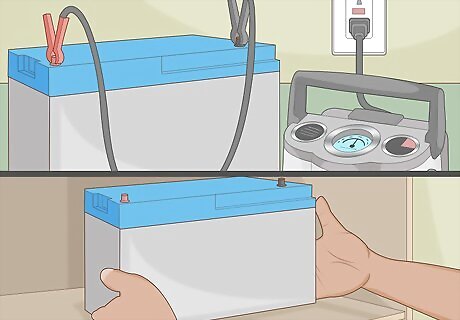
Recharge your battery after each use and before putting it into storage. If you let your lead acid battery run out of power before charging it, major sulfation can occur, causing your battery to permanently lose retention capacity. So it’s important to keep the battery as close to full capacity as possible. Storing your battery in a discharged state will reduce its life and negatively affect its overall performance. Charging your battery before putting it into storage is especially important if you’ll be storing it at higher temperatures.


















Comments
0 comment